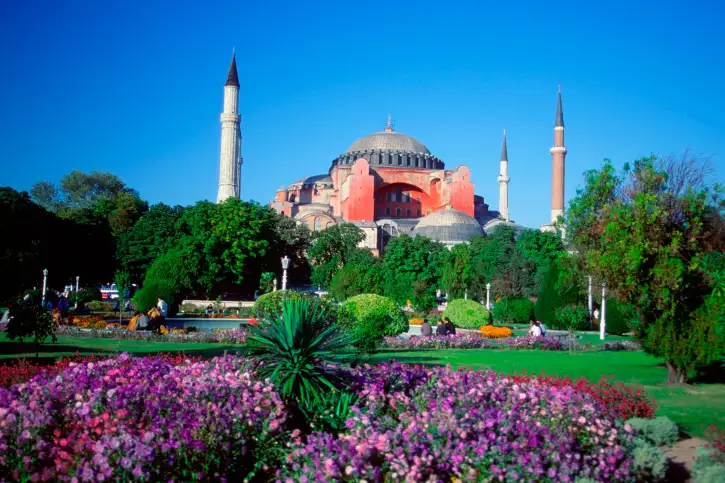
Follow contributing editor Ed Perkins as he embarks on a round-the-world “Joan Trip.” (What’s a Joan Trip? Find out in Take That Special Trip … While You Still Can.) According to Perkins, “neither frequent-flyer miles nor people improve with age,” so he’s working off a bundle of miles seeing the world, combining places he missed over the years with some old favorites. Read the rest of Perkins’ round-the-world-trip posts.
Istanbul’s three blockbuster attractions—the Blue Mosque, Hagia Sophia, and Topkapi Palace—are world class attractions in a very real sense. They’re highlighted in both the history books and the travel books, and often make those “ten best” or “top 20” lists travel magazines like to compile. That means they’re almost always crowded, with long lines to get in and all too often too many people in an individual room to see the room properly. But that comes with the territory. Just try to get a good look at the Mona Lisa when you’re at the Louvre. From what I saw, the best strategy is to get there just at opening time; crowds build later in the day.
Depending on the amount of detail you seek, you can do the Hagia Sophia and Blue Mosque in as little as a half hour or so. But the Topkapi complex includes lots of separate buildings and exhibits, and you’ll want to spend several hours there.
Turkey is planning to enter the euro zone, and, as a result, the euro is already a de facto second currency. Most of the hotel accommodations, tour packages, airport transfer services, and such are nominally priced in euros, and you can pay with euro currency, although you can pay in Turkish liras as well. The government-run museums and other services, however, specify “Turkish money only.”
As in so many other major visitor centers, a good way to get a feel for Istanbul is to take one of the two hop off, hop on open-top double-decker bus lines that circulate around the city. Locals say to take the “red” route; it costs 20 euros (about $28) and takes a little over an hour for a full circuit. Although it has six stopping points, the only places where it sells tickets and waits for customers are around the main square between the Hagia Sophia and Blue Mosque, and the central square in Taksim.
I found the locals to be extremely cordial hosts to visitors—and pretty good linguists, as well. Just about anybody on the street is glad to help with directions. However, when you’re walking around the Sultanahmet area, it’s all too easy to mistake a scam artist for a cordial and helpful individual. But shills abound: well-spoken, friendly types who usually start by asking “where are you from” and assuring you they’re not trying sell themselves as guides.
Their real aim, however, is not to extract the details of your home town; it’s to extract some of your money, by luring you into a nearby rug merchant’s emporium or art gallery. They really orchestrate it well: the friendly interest, a good command of whatever language you speak, and, usually, an invitation to a cup of tea. Without trying to be rude, my defense is to say, up front, “I have no intention of buying anything today and I’m not interested in looking at any rugs or art.”
Although Istanbul has a few international-class chic (and expensive) restaurants, most of the dozens of ordinary spots you see around town seem to post about the same menus: kabobs, pizza, pide (which they call Turkish pizza), and spaghetti. You almost think that someone prints up a standard display and sells it to all the places. In a separate strain, more than a dozen seemingly identical fish restaurants line the main boulevard along the Bosporus and Sea of Marmara waterfront. Actually, many of those ordinary tourist spots serve up some very tasty examples of the local cuisine. I had several nice dinners for 30 to 40 liras (including a big glass of draft beer).
Leaving Istanbul, travelers have to go through two separate and security screens—once just to get into the vast departure hall and again to get into the gate areas. I have no idea why the double effort is necessary, but both are relatively tight.
Double screening aside, Istanbul is visitor-friendly and accommodating. I highly recommend it, especially to those interested in world history.
You Might Also Like:
We hand-pick everything we recommend and select items through testing and reviews. Some products are sent to us free of charge with no incentive to offer a favorable review. We offer our unbiased opinions and do not accept compensation to review products. All items are in stock and prices are accurate at the time of publication. If you buy something through our links, we may earn a commission.
Top Fares From
Today's Top Travel Deals
Brought to you by ShermansTravel
Shop and Save with Country Inns...
Patricia Magaña
 Hotel & Lodging Deals
Hotel & Lodging Deals
$229 -- Chicago: Discounted Rates and...
Francesca Miele
 Hotel & Lodging Deals
$229+
Hotel & Lodging Deals
$229+
$188 -- Honolulu: Save on Oceanview...
Abigail Lamay
 Hotel & Lodging Deals
$188+
Hotel & Lodging Deals
$188+



